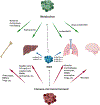Metastasis Organotropism: Redefining the Congenial Soil
- PMID: 31063756
- PMCID: PMC6506189
- DOI: 10.1016/j.devcel.2019.04.012
Metastasis Organotropism: Redefining the Congenial Soil
Abstract
Metastasis is the most devastating stage of cancer progression and causes the majority of cancer-related deaths. Clinical observations suggest that most cancers metastasize to specific organs, a process known as "organotropism." Elucidating the underlying mechanisms may help identify targets and treatment strategies to benefit patients. This review summarizes recent findings on tumor-intrinsic properties and their interaction with unique features of host organs, which together determine organ-specific metastatic behaviors. Emerging insights related to the roles of metabolic changes, the immune landscapes of target organs, and variation in epithelial-mesenchymal transitions open avenues for future studies of metastasis organotropism.
Keywords: EMT; immune microenvironment; metabolism; metastasis; niche; organotropism; seed and soil.
Copyright © 2019 Elsevier Inc. All rights reserved.
Figures





References
Publication types
MeSH terms
Grants and funding
LinkOut - more resources
Full Text Sources
Other Literature Sources

